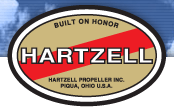Hartzell Propeller
 | |
| Industry | Aerospace |
|---|---|
| Founded | 1917 |
| Founder | Robert Hartzell |
| Headquarters | Piqua, Ohio, United States |
| Products | Aircraft propellers |
| Website |
www |
Hartzell Propeller was founded in 1917 by Robert Hartzell as the Hartzell Walnut Propeller Company.[1] Hartzell is an American manufacturer of composite and aluminum propellers for certified, homebuilt and ultralight aircraft. The company headquarters is located in Piqua, Ohio.[2]
The company produces propellers, spinners, governors, ice protection systems and other propeller controls.[2][3]
History
In an effort to get off his Union City, Indiana farm, 17-year-old John T. Hartzell borrowed $25, purchased a horse and a huckster wagon, and began his business career in 1860 selling lightning rods. In 1875 he founded the Hartzell Farm Wagon Company.[4]
In the 1890s, John's son George joined the company as a partner and it was renamed John T. Hartzell & Son, doing business as lumber suppliers and wagon manufacturers. George Hartzell purchased the company from his father and renamed it the George W. Hartzell Company.[5] He moved the company from Greenville, Ohio to Piqua, Ohio and set up a more modern sawmill. In 1915, the company manufactured gun stocks for the First World War.[5]
George’s son Robert N. Hartzell owned a small airplane and did maintenance as a young man. In 1917, Orville Wright suggested that Hartzell use its walnut trees to manufacture aircraft propellers. As a result Robert founded the Hartzell Walnut Propeller Company in Piqua and the company provided "Liberty" aircraft propellers for World War I warplanes.[6][7]
After the war, Hartzell built its own airplanes, including the FC-1 (the first aircraft made entirely of plywood).[8] The FC-1 took first place in the Flying Club of St. Louis Trophy Race at the 1923 International Air Meet.[8] An alteration to the wings resulted in the improved FC-2 model, which won over aircraft from the Waco Aircraft Company and the Curtiss Aeroplane and Motor Company) at the 1924 International Air Races in Dayton, Ohio. Hartzell stopped producing aircraft to avoid competing with its own propeller customers.[8] In 1926, Hartzell began building propellers for the Aeronca C-2.[9]
During World War II the company produced metal propellers for Hamilton-Standard. After the war, Hartzell produced the first composite propellers for the Republic Seabee. Hartzell began making aluminum propellers in 1948 and developed the first full-feathering propellers for a light twin-engine aircraft in the 1950s. These were used in the Aero Commander, the Piper Apache, the Cessna 310 and the Beech Twin Bonanza.[10]
Hartzell introduced a turboprop propeller in 1961 and in 1975 certified a 5-bladed propeller for the Shorts 330.[8][11] In 1978, the company produced a composite aramid fiber propeller for the CASA 212.[12] In 1989, Hartzell produced sixteen-foot propellers for the Boeing Condor, another record-breaking aircraft.[10]
Hartzell introduced Top-Prop, replacement propellers for piston-engine aircraft, in 1991 and sold 20,000 Top-Prop conversion kits between 1991 and 2013.[13]
In 1994, the company held the first Friends of Hartzell Air Show in Piqua, Ohio.[14] for which Hartzell developed its first aerobatic system. In 2013, the Red Bull Air Race World Championship chose Hartzell to provide 3-blade composite propellers, carbon fiber composite spinners and governors to race teams.[15] In 2006, the FAA granted Hartzell the first certification for an Advanced Structural Composite (ASC II) propeller for general aviation.[16]
See also
References
- ↑ Aerial Age: 4. 15 March 1920. Missing or empty
|title=(help) - 1 2 Purdy, Don: AeroCrafter - Homebuilt Aircraft Sourcebook, page 84. BAI Communications. ISBN 0-9636409-4-1
- ↑ Hartzell Propeller (2009). "Product Applications". Retrieved 8 February 2012.
- ↑ Hartzell Air Movement (2012). "Annual Report". Retrieved 17 January 2014.
- 1 2 Computerized Heritage Association (1999). "Memiors of the Miami Valley, George W. Hartzell". Retrieved 17 January 2014.
- ↑ The Cincinnati Enquirer (2003). "Hartzell Propeller Still Building on Historic Past". Retrieved 17 January 2014.
- ↑ WoodenPropeller.com (2005). "Early WWI Era Propellers". Retrieved 17 January 2014.
- 1 2 3 4 Keisel, Ken: Dayton Aviation: The Wright Brothers to McCook Field, page 126. Arcadia Publishing. ISBN 9780738593890
- ↑ The Aeronca Museum (1930). "Archive Database Record Details". Retrieved 17 January 2014.
- 1 2 Janet R. Daly Bednarek, Michael H. Bednarek: Dreams of Flight: General Aviation in the United States, page 142-143. Texas A&M University Press. ISBN 1585442577
- ↑ Conklin & de Decker Aviation Information (1930). "Aircraftpedia". Retrieved 21 January 2014.
- ↑ NotPlaneJane.com (1930). "Hartzell/Hartzite". Retrieved 21 January 2014.
- ↑ General Aviation News (29 July 2013). "Hartzell Top Prop 20,000 Ready to Take to the Air". Retrieved 22 January 2014.
- ↑ Hartzell Propeller. "A Long History of Innovation". Retrieved 22 January 2014.
- ↑ General Aviation News (13 November 2013). "Red Bull Taps Hartzell for Race Plane Props". Retrieved January 22, 2014.
- ↑ Aero News Network (24 July 2006). "Hartzell Intro's ASC-II Composite Prop". Retrieved 22 January 2014.